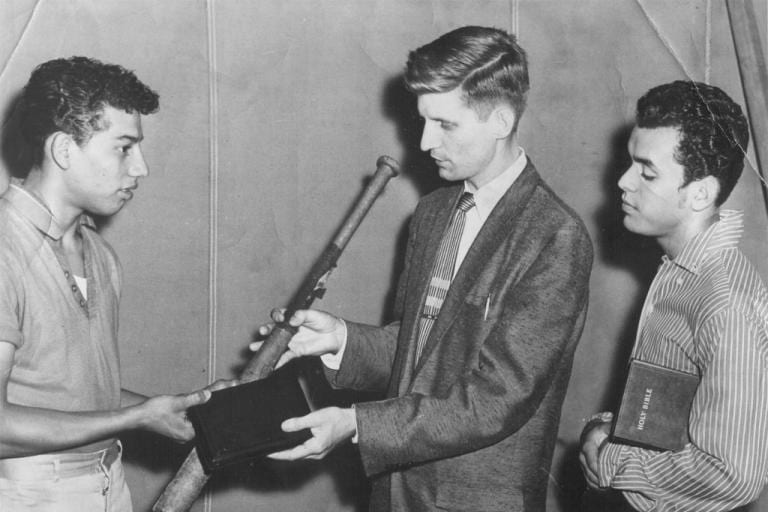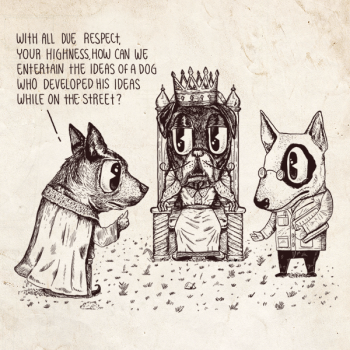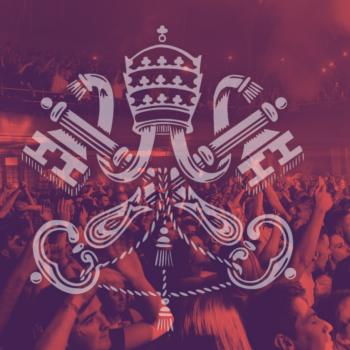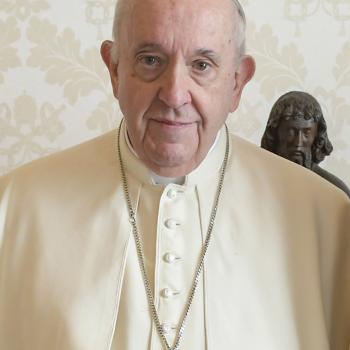In the summer of 1957, an article in Life magazine pricked David Wilkerson’s conscience. A slim twenty-six-year-old minister of an Assemblies of God congregation in the mountains of Pennsylvania, Wilkerson read about a grisly murder in Manhattan where gang members had killed a fifteen-year-old kid with polio. At first he was incensed at the gang. But then his heart softened as the Holy Spirit prompted him to “go to New York City and help those boys.”
So he did. Wilkerson drove through the night and found the courthouse where the gang members were being tried. As soon as he arrived, he stepped over the guardrail in the courtroom and interrupted the trial to tell them about God’s love. To the amusement of reporters in the room, the judge ordered him out. The next day Wilkerson found an unflattering picture and story about himself in the newspaper.
 Despite the humiliation, the experience launched Wilkerson on a long career as an evangelist on the gritty streets of New York City. He did a lot of street preaching, but he and his ministry Teen Challenge also began to work on issues of drug rehabilitation and urban violence. Famously, Wilkerson converted Nicky Cruz, a leader of the notorious Mau Mau gang. The scene in which Cruz hands over his weapons to Wilkerson, as Wilkerson gives Cruz a Bible, was memorialized in The Cross and the Switchblade, one of the best-selling religious books of the 1960s and 1970s. It—along with other cultural artifacts such as West Side Story, Rebel without a Cause, and The Outsiders—reflected a national and evangelical midcentury preoccupation with juvenile delinquency and crime.
Despite the humiliation, the experience launched Wilkerson on a long career as an evangelist on the gritty streets of New York City. He did a lot of street preaching, but he and his ministry Teen Challenge also began to work on issues of drug rehabilitation and urban violence. Famously, Wilkerson converted Nicky Cruz, a leader of the notorious Mau Mau gang. The scene in which Cruz hands over his weapons to Wilkerson, as Wilkerson gives Cruz a Bible, was memorialized in The Cross and the Switchblade, one of the best-selling religious books of the 1960s and 1970s. It—along with other cultural artifacts such as West Side Story, Rebel without a Cause, and The Outsiders—reflected a national and evangelical midcentury preoccupation with juvenile delinquency and crime.
A superb new book by Aaron Griffith (read an Anxious Bench interview with him here) called God’s Law and Order: The Politics of Punishment in Evangelical America explores the dimensions of this intense concern. First, he observes that evangelical outreach to criminals in the 1960s was a form of apologetics. If Teen Challenge could be demonstrated to use prayer and conversion as effective weapons in the war against drug addiction and crime, perhaps that validated the gospel itself—that it worked and that it was true. Indeed, Wilkerson boasted of success rates approaching 70 percent. As another example, Griffith tells the story of Roy Lundquist, a retired Sears analyst, who in retirement analyzed crime rates in places where Billy Graham appeared. His brightly colored charts showed that many locations enjoyed favorable reductions in crime immediately after Graham’s evangelistic crusades. Evangelicals quantified ministry success to demonstrate the empirical truth of the gospel.
Second, Griffith shows how ministries in this era reflected an individualistic anthropology. They insisted that personal choice, not social structures, produces sin. Individuals, not institutions, drive social reform and salvation. In one sermon Wilkerson preached, “Repentance can never be anything but your very own act. God will use forces to draw us but will never coerce our wills. . . . Repentance begins with a revelation and an admission of personal guilt. You cannot blame parents or environment or use any pathetic excuses of psychiatrists.”
 Third, urban ministries marshaled icons of sinfulness. As Griffith writes, “To hear evangelicals talk about cities was to hear stories of dark dens of delinquency, drugs, racketeering, and prostitution.” The trope drove some evangelicals, like Wilkerson, toward the city in efforts to redeem the darkness. But even more left the city in waves of white flight. In either case, they conceived of the ghettoes as unrelentingly godless.
Third, urban ministries marshaled icons of sinfulness. As Griffith writes, “To hear evangelicals talk about cities was to hear stories of dark dens of delinquency, drugs, racketeering, and prostitution.” The trope drove some evangelicals, like Wilkerson, toward the city in efforts to redeem the darkness. But even more left the city in waves of white flight. In either case, they conceived of the ghettoes as unrelentingly godless.
Griffith expertly illuminates the limits of these evangelical sensibilities. In his hurry to save souls and the city, Wilkerson often missed “the power of other causal factors, whether racism, poverty, or mental health issues.” In several bracing chapters Griffith also connects these themes to the more toxic law-and-order campaigns of the 1970s and 1980s. These efforts emphasized punitive punishment. Carl Henry, for example, printed a defense of capital punishment in the pages of Christianity Today suggesting that “in the present depraved conditions, we might even wisely execute adulterers and pornographers.” Law-and-order campaigns, often orchestrated and cheered by evangelicals, also led to a system of mass incarceration that disproportionately targeted people of color.
Along the way, however, Griffith pauses this narrative to make an important point: that it didn’t have to turn out that way. Wilkerson himself was not a proponent of the Southern Strategy. Indeed, Griffith insists that Teen Challenge represented an authentic effort at compassion. Wilkerson’s strategy, he writes, “allowed for personal encounters and relationships with a population otherwise reduced to faceless statistics in the bureaucratic apparatus of state power, both progressive and punitive.” We might cringe at Wilkerson’s colorblind assertion that criminals “just happened” to be black and brown, but perhaps this represented improvement over even more overt forms of racism in the Jim Crow South and the urban North before the civil rights movement—and the racialized forms of mass incarceration that mushroomed in the succeeding decades.
Indeed, some white evangelicals in the city—people like Jim Wallis and Ron Sider of the evangelical left—did begin to more fully consider the structural nature of poverty and crime. Even Chuck Colson, a criminal himself and future luminary of the religious right, pushed against punitive approaches to crime. In other words, there were multiple paths. Griffith writes that it is important to “historicize evangelicals’ punitive exploits in criminal justice: it was not always this way, and it was not a foregone conclusion that evangelicals would travel this path.”
It is possible that Wilkerson’s colorblindness, which seemed so enlightened at the time but seems so disingenuous now, could have evolved into cooperation with the Chicago Declaration, which stated . . . “We acknowledge that God requires justice. But we have not proclaimed or demonstrated his justice to an unjust American society. Although the Lord calls us to defend the social and economic rights of the poor and oppressed, we have mostly remained silent. We deplore the historic involvement of the church in America with racism and the conspicuous responsibility of the evangelical community for perpetuating the personal attitudes and institutional structures that have divided the body of Christ along color lines.”
Alas, evangelical politics didn’t follow this path. But Griffith calls for a new direction on the part of evangelicals who feel the pull of law-and-order politics. In a moving conclusion he writes that to truly proclaim freedom to the captives “there will need to be widespread repentance of past punitive sins. This will be particularly hard for those evangelicals who want to believe in their movement’s internal integrity and a timeless gospel witness. But repentance like this might better be seen as a conversion. And conversions are what evangelicals do best.”
In this, Griffith resonates with two other recent critical histories of evangelicalism. In The Color of Compromise, Jemar Tisby writes, “If racism can be made, it can also be unmade.” In Jesus and John Wayne, Kristin Kobes DuMez concludes, “What was once done might also be undone.” These statements simultaneously suggest the contingent nature of history and represent a plaintive call for the evangelical tradition to do better.













